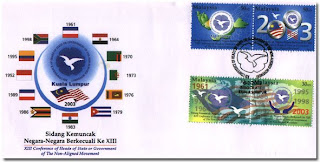 The Non-Aligned Movement
The Non-Aligned MovementHistorical Background
The formation of the Non-Aligned Movement (NAM) can be traced back to the newfound sentiments and determination of the leaders of 29 Asian and African countries, most of which were then newly independent ones that participated in the Asian-African Conference, more popularly known as the Bandung Conference, held in Bandung, Indonesia from 18-24 April 1955.
The Bandung Conference discussed the possible measures that these countries could implement in enhancing close cooperation in the fields of politics, economy and culture. The main trust of the Final Communique of the Conference was the Dasa Sila Bandung (The Ten Principles of Bandung) which provided an agreed premise for them to govern the conduct of relations among themselves as well as with other countries in the said fields of cooperation.
 Establishment
EstablishmentAt the collective initiative of President Josip Eroz Tito of the then Socialist Federal Republic of Yugoslavia, President Gamal Abdel Nasser of Egypt, Prime Minister Jawalharlal Nehru of India, and President Ahmad Soekarno of Indonesia, and with the co-sponsorship of Afghanistan, the Preparatory Meeting for the 1st Conference of Heads of State or Government of NAM (1st NAM Summit) was convened, in Cairo, Egypt from 5-12 June 1961. The meeting was aimed at conducting "a general discussion in an atmosphere of friendship and understanding or questions relating to the holding of the 15t NAM Summit".
As recommended by the aforementioned Cairo Preparatory Meeting, the 1st NAM Summit was held in Belgrade, Yugoslavia from 1-6 September 1961. Thus, the convening of the Summit marked the birth of NAM.
Since the 1st NAM Summit in Belgrade in 1961, 11 subsequent Summits were held which involved ever-increasing participation by the developing countries. Currently, the NAM is represented by 114 member countries, 16 observer countries, 7 observer organizations, 31 quest countries and 42 guest organizations.
Malaysia was officially brought into the fold of the Movement as a member country with its participation in the Informal Meeting of the Ministers of Foreign Affairs of NAM at New York on 27 September 1969. Subsequently, the Malaysian Delegation, led by Tun Abdul Razak as the then Prime Minister, attended its first ever Summit as a member country at the 3rd NAM Summit in Lusaka, Zambia from 8-10 September 1970.
Principles and Objectives
The appeal of NAM lies both in its origin as well as its principles and objectives. The idea grew out of a desire of a great majority of newly independent countries of Asia, Africa, Europe and Latin America and the Caribbean to be free from any alignment in the then rigidly bipolar world. Such a sentiment was able to reduce tension and safeguard their newfound independence and national integrity.
 The XIII NAM Summit
The XIII NAM SummitThe Conference of HOSIGs or NAM Summit is the highest decision-making authority of the Movement. The existing practice is to hold the Summit once in every three years. Malaysia is deeply honored for being unanimously endorsed by the member states of NAM during the Ministerial Meeting of the Coordinating Bureau of NAM in Qurban, South Africa from 27-29 April 2002 as the host country of the XIII NAM Summit as well as its Chair for 2003-2006. Malaysia's readiness in hosting the XIII NAM Summit and assuming the NAM Chair is a testimony to its strong commitment to the Movement.
Malaysia and the Non-Aligned Movement
Malaysia recognizes the importance of NAM as a major forum for consultations and co-ordination of positions on political and economic issues of importance among the developing countries. The Movement must continue to strive for a global order that is peaceful, secure and oriented towards prosperity, justice and equality, a world in which the worth of the human person and the sovereignty of states are upheld. The vitality and relevance of the Movement as a vehicle to achieve these goals should be further strengthened and broadened based on the commonality of interests and shared concerns, without sacrificing its founding principles.
As a body representing almost two-thirds of the sovereign states of the world, NAM's potential in shaping an international order that takes into account the concerns of the developing countries could be further enhanced. Malaysia, as the upcoming Chair of NAM will endeavor to further promote this aim with the cooperation of the larger NAM membership.
Technical Details
Date of Issue : 6-Feb-2003
Stamp Value : 30 Sen ( Setenant ); 50 Sen ( Setenant )
Stamp Size : 40mm X 30mm
Perforation : 14
Sheet Content : 20 Stamps
Paper : SPM Watermarked, Phosphor Coated
Printing Process : Lithography
First Day Cover Value : 30 Sen
|
|






0 comments:
Post a Comment